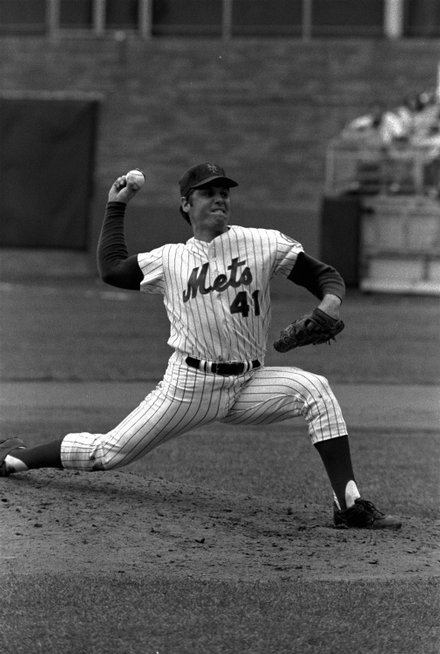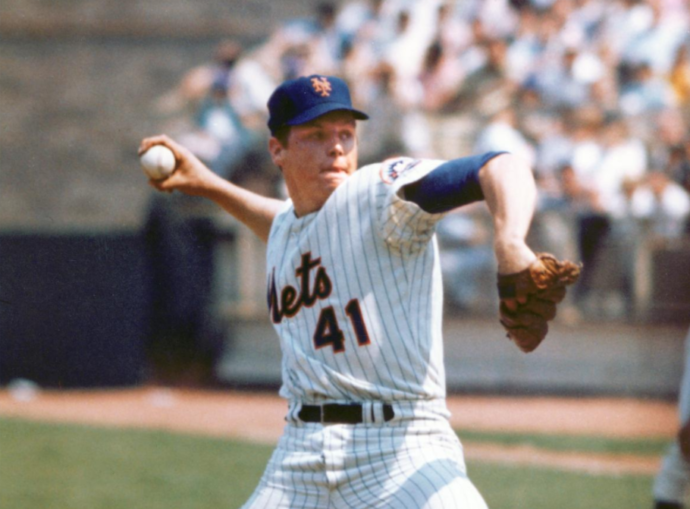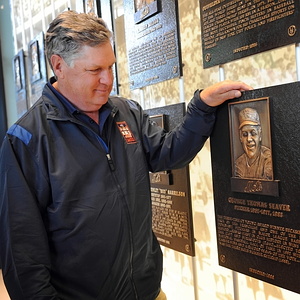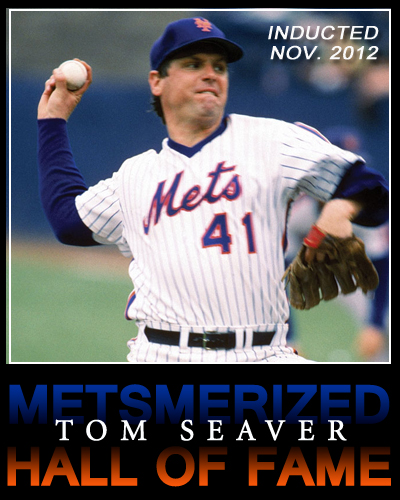The Franchise: The Name Says It All
One of the many great things about the history of Baseball is the abundance of nicknames. Some are based around physical appearance of a player: The Splendid Splinter, Pee Wee, Three Finger, The Beard. For others, the way they played the game is summed up in a nickname: Mr. October, The Wizard, The Iron Horse, Nails. Other monikers can be classified as downright intimidating: Hammerin’ Hank, The Ryan Express, Louisiana Lightning, The Mad Hungarian. In certain cases the nickname has, for all and intents and purposes, become their first name just because it sounds better: The guy who hit those 714 HR’s–George Ruth. The CFer for the Brooklyn Dodgers–Edwin Snider. The outfielder who hit a slow roller to Buckner–William Wilson.
Then, there is The Franchise. This tells us nothing about Tom Seaver’s physical appearance, his professional demeanor on the mound and honestly, is not really even that cool. However, it tells everyone exactly what they need to know. Simply put, Tom Seaver WAS The Franchise.
The 22 year old made his Major League debut on April 13, 1967. Facing Clemente, Stargell and the rest of the Pittsburgh Pirates, Seaver pitched 5 1/3 innings, allowing 2 ER and striking out 8. Although he got a no-decision, the Mets won the game. Yes, it was only the 2nd game of the year but the Mets had pulled to .500. Always a bright spot of us fans. The previous day we lost 6-3. The following day we lost 5-1. One week later, April 20, Seaver shut down the Cubs, 6-1. It was his first win. There would be 310 more to follow.

Tom Seaver would go on to win the NL Rookie of the Year with a 2.76 ERA, 170 K’s and 16 wins for a team that only won 61. It was the first time in the short history of this franchise that Mets fans saw hope for a bright future. Tom Terrific was our first superstar. At least once every five days this club had a pretty good shot at putting up a “W.” The days of being the lovable losers were coming to an end.
George Thomas Seaver played in an era when pitching dominated the game. But Seaver dominated pitching. The Franchise was not just one of the best pitchers of his time. He was one of the best in history. He used what was known as ‘Drop and Drive,’ a style of pitching perfected by Christy Mathewson. Seaver relied on strength in his legs to ease the pressure on his arm and in turn prolong his career that was relatively injury free. One could easily tell how well Seaver was in command by looking at the amount of mound dirt on his knee.
In just his 3rd year in the majors, 1969, Seaver won 25 games, a team record which still stands. On July 9 that year, he threw a perfect game for 8 1/3 until giving up a bloop hit to Jimmie Qualls. As great an accomplishment as this would be under any circumstances, the fact that it came against the first place Cubs was that much sweeter. Seaver put the entire league on notice that the New York Mets, for the first time in history, were a serious contender. He posted a 2.21 ERA, struck out 208 and won his first of three Cy Young Awards. He was runner up in MVP voting, finishing second to Willie McCovey.
In Game 4 of the World Series, Seaver shut down the Orioles, pitching 10 innings en route to a Mets 2-1 victory. (Sorry, I don’t know what the pitch count was). The following day the Mets were World Champions.
Seaver had won the hearts of Mets fans. But it was only the beginning.
In one of his first starts the following April, Seaver whiffed 19 Padres, including the last 10 he faced. The 19 K’s tied the major league record at that time.
He stated his best season was 1971. He led the league in strikeouts with 289 (in 286 IP) and ERA (1.79). However, it was Fergie Jenkins who won the Cy Young due primarily to the fact he had more wins.
The Franchise led the NL in strikeouts 5 times and ERA 3 times. He represented the Mets in the All Star game 9 different occasions between 67 and 76.
Tom Seaver also pitched for the Reds, White Sox and Red Sox throughout his 20 year career. At the time he retired he was 3rd in strikeouts with 3640, behind only Ryan and Carlton. His career average of 6.85 K/9 IP is 2nd only to Ryan of any Hall of Famer with 300 wins. He holds the Major League record of 9 consecutive seasons of 200 or more strikeouts. His career ERA of 2.86 is 3rd lowest in the Live Ball era. His 61 shut-outs ties him with Nolan Ryan for the most by a RHP during the Live Ball Era — 8th all-time.
At the end of the twentieth century The Sporting News listed Seaver as the 11th best pitcher in Baseball history. ESPN took a poll of some of Tom’s contemporaries: Bob Gibson, Juan Marichal, Nolan Ryan, Steve Carlton, Bert Blyleven and Don Sutton all agreed that it was Seaver who was the best of their generation. Reggie Jackson once said of Seaver, “Blind men come to the park just to listen to him pitch.” In his first year of eligibility, 1992, Tom Seaver was elected to the Hall of Fame with 99.84%, the highest ever recorded.
So, yes, Tom Seaver was a great pitcher. But bringing this full circle, let’s not forget his nickname: The Franchise. Tom remains the Mets leader in wins (198), ERA (2.57), Strikeouts (2541), Shutouts (44), IP (3045 1/3), starts (395), WHIP (1.08) and is 3rd in OAV (219).
Before his arrival the Mets were a joke, a doormat for the National League. With the coming of #41, the Mets had taken the first step to respectability. But as much of a positive impact as his arrival had, his departure brought with it the darkest time in team history.
After M. Donald Grant sent Seaver to Cincinnati in The Midnight Massacre of June 15, 1977, the Mets immediately returned to their pre-Seaver days. The team went on to lose 45 of their remaining 75 games that year and finished in last place for the first time in a decade. The Mets would finish last again in 78 and 79. The 3 straight seasons of finishing last was not something they had done since 1963-1965. Seaver’s dismissal was a big stab in the heart to fans. It took the club nearly ten years to recover.
Attendance dropped to Expos-esque numbers. Shea became known as Grant’s Tomb and frequently the upper level, sometimes upper two levels, were not even opened. In 1979, with the reality of Seaver’s absence setting in, the Mets averaged an embarrassing 9740 fans per game. Seaver’s impact, or lack thereof, was felt on the field as well as in the stands and standings.
From 1968 through 1976, with Tom at the top of our rotation, the Mets averaged 83 wins per year. After Seaver left, from 1978 through 1983 (excluding the strike season of 81), the Mets averaged just 65 wins per year, 18 less with Seaver gone.
If that doesn’t prove his value and importance, here’s something else to consider. From 68-76, the Mets record was 743-714. Seaver’s record during that period was 166-94. The Mets, as a team, were only 29 games over .500. Tom Seaver was 72 games over .500.
It’s been nearly 30 years since this Hometown Hero donned the blue and orange. Yet, he still remains the face of this team. When I told some friends—Mets fans and non-Mets fans—of my involvement in selecting 5 Mets to be enshrined in the Metsmerized Hall of Fame, the first name every one mentioned was Tom Seaver…and 4 others. Seaver is, and always will be, in a class by himself. Seaver is and always will be The Franchise.
It’s with great pleasure that we announce Tom Seaver as the first player to be enshrined into the…
Metsmerized Hall of Fame

















